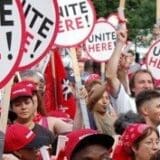

 In my post last week, after the announcement that the employer mandate would not be enforced for a year, I wrote that it was vital that the Obama administration show as much concern for the workers who might be denied health insurance as it did for employers. Specifically, I asked the administration to make clear that a worker would be able to get subsidized health coverage through the new exchanges based on filling out an application, without having to get proof from an employer. On Friday [July 5, the Department of Health and Human Services] issued that ruling.
In my post last week, after the announcement that the employer mandate would not be enforced for a year, I wrote that it was vital that the Obama administration show as much concern for the workers who might be denied health insurance as it did for employers. Specifically, I asked the administration to make clear that a worker would be able to get subsidized health coverage through the new exchanges based on filling out an application, without having to get proof from an employer. On Friday [July 5, the Department of Health and Human Services] issued that ruling.
The decision not to enforce the employer mandate for a year is certain to cost some people health coverage as some employers decide to postpone complying with the law. Their workers, possibly also confused by the delay, may not apply for subsidized coverage. But if they do apply, the new ruling will be a big help to them.
» Read more about: How Obamacare Mandate Delay Helps Workers »


You’ve probably heard it from a colleague, or maybe from a friend or family member:
“Kids these days… they’re just too ambivalent to care about labor unions or workers’ rights.”
But as it turns out, that’s just not true. Young people are actually big fans of unions. Fully 61 percent of young people view labor unions favorably – and that’s more than 10 points higher than the national average, according to a new Pew poll. In fact, young people are the only age group that views unions more favorably than they view corporations.
But despite the overwhelming support young people have for unions, they’re far less likely to belong to one. Harold Meyerson writes in the American Prospect:
The irony for unions —and in theory, the opportunity—is that the youngest Americans are the least unionized.


Helicopters hover like hellish hogs
of Armageddon:
an infra-red shakedown.
We are the enemy, the face on the radio;
burnt petals cluttering the sidewalk.
We are daylight’s demise, dancing between
discord & distrust. All is bitter harvest,
betrayal and bewilderment;
all is seed for the fields of retreat:
bullets punctuate every poem.
——————————————————–
Source: Trochemoche, published by Curbstone Press (1998).
Luis Rodrίguez has won numerous awards for his poetry, including the Poetry Center Book Award, a PEN Josephine Miles Literary Award, and a Paterson Poetry Book Prize. He is best known for the 1993 memoir of gang life, Always Running: La Vida Loca, Gang Days in L.A. (paperback by Touchstone Books/Simon & Schuster).


Tomorrow the fate of Chinatown residents and small businesses will be decided by the Superior Court. For the past 18 months, Chinatown residents and community activists across the city have been fighting Walmart’s attempt to open a grocery store in the historic downtown neighborhood. Now a judge will weigh the right of Asian-American communities to have a voice in what is built in their neighborhoods versus a multinational corporation’s ability to open just one more store. The lawsuit filed by the Asian Pacific American Labor Alliance (APALA) and its allies seeks to nullify the building permits granted to Walmart by L.A. city officials.
As we at APALA prepare for the trial, I have been reflecting on our civil rights and labor struggles in the Asian-American community. It’s the same battle that Chinatown residents fought against Union Station displacement and that Japanese Americans fought to reclaim Little Tokyo in the wake of internment camps and recent gentrification.


 Judy West is a founding member and current president of Local 741 of the American Federation of State, County and Municipal Employees union (AFSCME). She also works for the Los Angeles Department of Recreation and Parks as a recreation assistant and teaches “parent-and-me” classes. The department’s only fulltime employees are its directors and other administrators – assistants like West work halftime. Frying Pan News reporter Luke Dowling sat down with her to talk about the state of unions in Los Angeles.
Judy West is a founding member and current president of Local 741 of the American Federation of State, County and Municipal Employees union (AFSCME). She also works for the Los Angeles Department of Recreation and Parks as a recreation assistant and teaches “parent-and-me” classes. The department’s only fulltime employees are its directors and other administrators – assistants like West work halftime. Frying Pan News reporter Luke Dowling sat down with her to talk about the state of unions in Los Angeles.
Frying Pan News: Tell me a little about yourself and how you came to be president of AFSCME Local 741.
Judy West: I was one of its organizers and was treasurer for a while, then became president. We had nothing before we organized. When a union rep came in and said, “We’ve been asked by different rec assistants to organize a union,” I said,


You get the basics in high school. The federal government is divided into three branches (executive, legislative, judicial). Locally you’ve got the mayor and the city council. Etc. Most of us don’t graduate with enough knowledge so that as adults we truly grasp how even the most well-known governmental power structures really work (what percentage of Americans can actually explain the Electoral College?), let alone more obscure power centers.
The Long Beach Coalition for Good Jobs and a Healthy Community is aiming to redress this lack of knowledge through a series of Power Analysis Workshops (or PAWs), which the coalition says are intended “to build collective knowledge of the power of local government [, …] of where branches of government get their power, how they impact the community and how residents can ensure local government works for all residents.”
“It’s important that all residents are engaged in the political process and understand how the decisions their representatives make impact their daily lives,” says Christine Petit,
» Read more about: Teaching the ABCs of Power in Long Beach »


 An old friend I’m back in touch with thanks to Facebook loves to rail against Facebook — on Facebook. When our electronic bond progressed to a real-world lunch, he lamented that he had joined Facebook for its networking promise, but has become unnerved by a growing sense that his Facebook Page belongs not to him but to, yes, Facebook.
An old friend I’m back in touch with thanks to Facebook loves to rail against Facebook — on Facebook. When our electronic bond progressed to a real-world lunch, he lamented that he had joined Facebook for its networking promise, but has become unnerved by a growing sense that his Facebook Page belongs not to him but to, yes, Facebook.
I could relate. A bizarre posting or a stealth ad on Facebook can trigger a flash of disorientation. Does it emanate from a friend, a friend of a friend, a mutual friend, a frenemy posing as a friend, someone I “should get to know” or a multi-national corporation? How did those unflattering pictures of me insinuate themselves, unbidden, into my profile? And how can it be that I’m now, at this precise instant, listening — “on Spotify” — to a song I’ve never heard of?
It might be satisfying for counter-culture types to blow off steam by rebelling against a mega-corporation that markets itself as the hip vanguard of the communications revolution to mask its true establishment-promoting,


In a far-reaching victory for hotel workers, a new labor agreement has been reached between the national Hyatt hotel chain and UNITE HERE, which represents Hyatt workers in Los Angeles, San Francisco, Hawaii and Chicago. The accord caps a long, tenacious fight by the union. In a memo emailed to union affiliates, UNITE HERE national president D. Taylor thanked union activists and elected leaders whose efforts over the last two years have led to “substantial wage increases and quality health and pension benefits.”
The two sides issued this joint statement last week:
National Agreement
Today Hyatt Hotels Corporation and UNITE HERE, the union of hospitality workers in the U.S. and Canada, announced a national agreement that resolves longstanding disputes between the two organizations. The agreement creates a framework for the company and the union to work together moving forward. Both UNITE HERE and Hyatt hailed the pact as a positive step.


Gallup and Pew concur: Just over one-half of Americans approve of labor unions.
In late June, the Pew Research Center released the results of its biennial poll on unions and corporations, and reported that 51 percent of Americans had a favorable view of unions—up from just 41 percent in 2011, the last time Pew popped the question. Pew’s new number is almost identical to Gallup’s, which found that 52 percent of Americans approved of unions when it last asked that question in August of 2012. Gallup polls on union approval every year and has reported a 52 percent approval rating each of the past three years. Before then, union approval had hit an all-time low for Gallup surveys, with just 48 percent in 2009.
(This post first appeared on the American Prospect and is republished with permission.)
» Read more about: New Polls Show Rising Approval of Unions »


(Spoiler Alert: The last paragraph of this review of Timothy Sheard’s novel, A Bitter Pill, reveals plot endings.)
When a business-oriented company takes over the management of the James Madison Medical Center in Philadelphia, Pennsylvania, it is immediately clear that things are about to change, and not for the better. The sudden appearance of the Committee to Save James Madison – supposedly established by a group of disgruntled employees who don’t think the union has their best interests at heart, but in actual fact created by Croesus Health Care, the new owners of the hospital – is the first clue that the bosses are eager to crush the workers’ organization, fire staff and focus on the bottom line, service delivery be damned. In short order, everyone’s work life is turned upside down as a petition drive to decertify said union to “save jobs” leads to mayhem, murder and more.